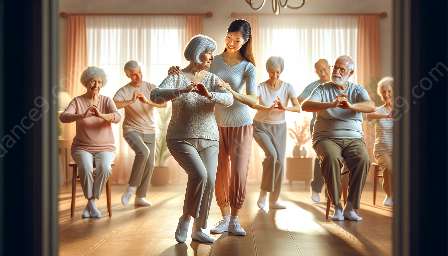Do you want to learn about the powerful impact of dance therapy on the mental well-being of individuals struggling with anxiety and depression? In this comprehensive guide, we will delve into the world of dance therapy and its positive effects on wellness. We will also explore how performing arts, particularly dance, can serve as an effective tool in promoting mental health and recovery.
Understanding Dance Therapy
Dance therapy is a therapeutic approach that harnesses the expressive and physical aspects of dance to support the emotional, cognitive, and social well-being of individuals. It offers a non-verbal form of communication and exploration, creating a space for emotional release and self-discovery. Through movement and creativity, dance therapy aims to address mental health concerns, including anxiety and depression, by integrating the mind and the body.
The Benefits of Dance Therapy
Dance therapy has been shown to offer a range of benefits for individuals struggling with anxiety and depression. By engaging in movement and dance, participants experience a release of emotional tension and stress, leading to a sense of relaxation and peace. The rhythmic and repetitive nature of dance can also help regulate breathing and heart rate, thus reducing symptoms of anxiety and depression.
Moreover, dance therapy promotes self-expression and self-esteem, allowing individuals to connect with their emotions in a safe and supportive environment. Through movement and artistic expression, participants can gain a deeper understanding of their feelings and experiences, paving the way for healing and personal growth.
Incorporating Dance into Wellness Practices
As part of overall wellness, dance therapy plays a significant role in cultivating a holistic approach to mental health. Integrating dance into wellness practices not only provides a form of physical activity but also nurtures emotional well-being. The creative and artistic elements of dance offer a unique avenue for individuals to explore and process their thoughts and emotions, contributing to a balanced and healthy lifestyle.
Connecting Dance and Performing Arts
When discussing dance therapy in the context of wellness, it is important to acknowledge the broader impact of performing arts, specifically dance, on mental well-being. The world of performing arts offers a rich tapestry of creative expression and artistic exploration, providing individuals with a platform to engage with their inner world and connect with others on a profound level.
Through dance performances and artistic collaborations, individuals can find solace, inspiration, and a sense of community, all of which are integral to combatting feelings of anxiety and depression. The collective experience of engaging in dance and witnessing the power of performance can foster a sense of belonging and purpose, contributing to a positive sense of self and emotional resilience.
In Conclusion
Dance therapy stands as a transformative and impactful intervention for individuals grappling with anxiety and depression. Its integration into wellness practices and the broader context of performing arts underscores its value as a holistic approach to mental well-being. By embracing the therapeutic qualities of dance, individuals can embark on a journey of self-discovery, healing, and empowerment, ultimately leading to a more fulfilling and balanced life.
Topic
Introduction to Dance Therapy for Anxiety and Depression
View details
Understanding the Role of Dance in Wellness and Mental Health
View details
Evidence-Based Practices in Dance Therapy for Mental Health
View details
Cultural Sensitivity in Dance Therapy for Anxiety and Depression
View details
Challenges and Opportunities in Implementing Dance Therapy
View details
Integration of Dance Therapy with Other Mental Health Treatments
View details
Long-Term Benefits and Sustainability of Dance Therapy Interventions
View details
Resilience-Building and Coping Skills in Dance Therapy
View details
Case Studies in Successful Application of Dance Therapy
View details
Psychological and Physiological Mechanisms of Dance Therapy
View details
Adaptation of Dance Therapy for Different Age Groups
View details
Tailoring Dance Therapy Programs for Individuals with Anxiety and Depression
View details
Role of the Therapist in Dance Therapy Sessions
View details
Active Engagement and Empowerment in Dance Therapy
View details
Social and Emotional Aspects of Dance Therapy for Anxiety and Depression
View details
Expression and Management of Emotions in Dance Therapy
View details
Evidence-Based Techniques in Dance Therapy Interventions
View details
Funding and Resources for Implementing Dance Therapy Programs
View details
Destigmatization of Mental Health through Dance Therapy
View details
Progress Measurement and Outcome Evaluation in Dance Therapy
View details
Current Trends and Future Directions in Dance Therapy for Anxiety and Depression
View details
Questions
What are the key principles of dance therapy for managing anxiety and depression?
View details
How does dance therapy contribute to the mental well-being of individuals with anxiety and depression?
View details
What research supports the effectiveness of dance therapy in addressing anxiety and depression?
View details
What are the best practices for integrating dance therapy into mental health treatment for anxiety and depression?
View details
What are the ethical considerations when utilizing dance therapy for individuals with anxiety and depression?
View details
How does cultural diversity impact the application of dance therapy for anxiety and depression?
View details
What are the challenges and opportunities in using dance therapy for individuals dealing with anxiety and depression?
View details
How can dance therapy be combined with other therapeutic approaches for managing anxiety and depression?
View details
What are the potential long-term benefits of dance therapy for individuals with anxiety and depression?
View details
How can the effectiveness of dance therapy interventions for anxiety and depression be evaluated?
View details
How can dance therapy support individuals with anxiety and depression in building resilience and coping skills?
View details
What are some examples of successful case studies using dance therapy for anxiety and depression?
View details
What are the physiological and psychological mechanisms through which dance therapy affects anxiety and depression?
View details
How can dance therapy be adapted for different age groups dealing with anxiety and depression?
View details
What are the key considerations for developing tailored dance therapy programs for individuals with anxiety and depression?
View details
What role does the therapist play in facilitating dance therapy sessions for anxiety and depression?
View details
How can individuals with anxiety and depression actively engage in their own healing through dance therapy?
View details
What are the ways dance therapy can address the social and emotional aspects of anxiety and depression?
View details
How can dance therapy empower individuals with anxiety and depression to express and manage their emotions?
View details
What evidence-based techniques are commonly used in dance therapy for anxiety and depression?
View details
What are the funding and resources available for implementing dance therapy programs for anxiety and depression?
View details
How can dance therapy contribute to destigmatizing mental health issues related to anxiety and depression?
View details
What strategies can be used to measure the progress and outcomes of dance therapy for anxiety and depression?
View details
How can dance therapy be integrated into educational settings to support students with anxiety and depression?
View details
What are the current trends and future directions in the field of dance therapy for individuals with anxiety and depression?
View details




























